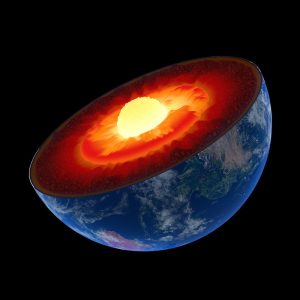
The spin of the Earth’s core appears to have reversed direction; but don’t be alarmed, it’s still spinning in the right direction, it only appears to be running in reverse from our vantage point here on the surface of the planet.
A study of deep-penetrating seismic data collected between 1964 and 2021 conducted by two researchers at China’s SinoProbe Lab at Peking University has revealed that the Earth’s inner core is now rotating slightly slower than the rest of the planet, and started to fall behind sometime in 2020. Although it is still rotating from west to east (something that is extremely unlikely to change, considering the core is a solid sphere similar in mass to Saturn’s moon Titan), to anyone observing the core from the surface of the planet, it appears to be rotating backward.
Broadly speaking, there are four main layers of material that make up the Earth underneath our feet: ranging between five and 70 kilometers (three to 44 miles) deep is the lithosphere, better known as Earth’s crust. The crust floats on top of a 2,890 kilometer (1,796 mile)-deep layer of melted silicate rock the consistency of caramel called the mantle; this is divided into two distinct layers; it is the slow-moving convection currents in this layer that drives tectonic activity, such as earthquakes, in the Earth’s crust above.
Below this, the outer core descends to a depth of 5,150 kilometers (3,200 miles) beneath the surface; this liquid shell is composed mostly of iron and nickel. It is theorized that the Earth’s magnetic field is produced in this layer, generated by convection currents in the liquid metal that act like giant electromagnets.
At the center of it all lies the inner core, a 2,440-kilometer (1,520-mile)-wide sphere that is a little less than three-quarters the size of the Moon; the pressure here is so great that the iron-nickel alloy it is composed of is solid—possibly even crystalline in structure—despite being so hot that it is the same temperature as the surface of the Sun.
Being a solid sphere, the inner core spins along with the rest of the planet—more or less—but due to the more fluid layers between it and the crust, the inner core usually spins somewhat out of sync with the planet’s surface; sometimes the core spins faster, and sometimes both spheres rotate at the same speed, giving the impression to an observer on the surface that the core is standing still.
But sometimes the inner core’s rate of rotation is slower than what is found at the surface, making it look like the core has changed its direction of rotation, despite still rotating in an eastward direction. Within the modern seismographic record, the core has done this at least once before, during the late 1960s and early 1970s, and started falling behind in relation to the rest of the planet’s rotation again in 2020, following a stationary period that started somewhere around 2009. It’s also important to note that this difference in rotation isn’t terribly dramatic, with the core’s rotation lagging behind the rest of the planet by only about one-fifth of a second.
Although the data used in the study only reaches back 56 years, the researchers estimate that this back-and-forth relationship between the inner core and the crust operates on a six to seven decade cycle, one that the researchers expect to be able to better define as more data is collected. And since this has happened in the recent past we can expect this subrotation to have little effect on the surface of the planet, outside of perhaps a change in the length of a day by roughly one thousandths of a second.
Subscribers, to watch the subscriber version of the video, first log in then click on Dreamland Subscriber-Only Video Podcast link.